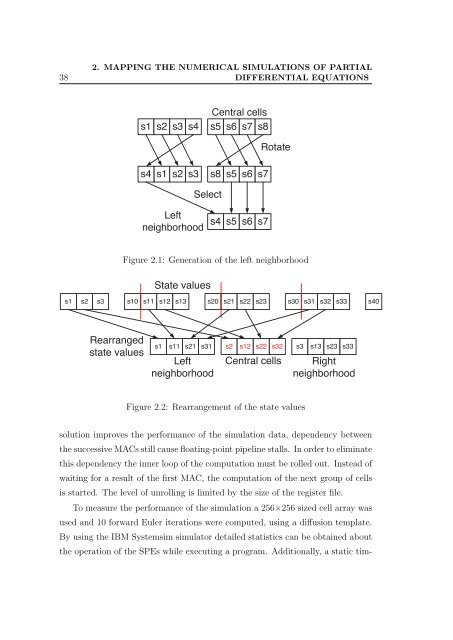PPKE ITK PhD and MPhil Thesis Classes
PPKE ITK PhD and MPhil Thesis Classes
PPKE ITK PhD and MPhil Thesis Classes
Create successful ePaper yourself
Turn your PDF publications into a flip-book with our unique Google optimized e-Paper software.
38<br />
2. MAPPING THE NUMERICAL SIMULATIONS OF PARTIAL<br />
DIFFERENTIAL EQUATIONS<br />
s1 s2 s3 s4<br />
Central cells<br />
s5 s6 s7 s8<br />
Rotate<br />
s4<br />
s1 s2 s3<br />
s8<br />
s5 s6 s7<br />
Select<br />
Left<br />
neighborhood<br />
s4 s5 s6 s7<br />
Figure 2.1: Generation of the left neighborhood<br />
State values<br />
s1 s2 s3 s10 s11 s12 s13 s20 s21 s22 s23 s30 s31 s32 s33 s40<br />
Rearranged<br />
state values<br />
s1 s11 s21 s31 s2 s12 s22 s32 s3 s13 s23 s33<br />
Left<br />
neighborhood<br />
Central cells<br />
Right<br />
neighborhood<br />
Figure 2.2: Rearrangement of the state values<br />
solution improves the performance of the simulation data, dependency between<br />
the successive MACs still cause floating-point pipeline stalls. In order to eliminate<br />
this dependency the inner loop of the computation must be rolled out. Instead of<br />
waiting for a result of the first MAC, the computation of the next group of cells<br />
is started. The level of unrolling is limited by the size of the register file.<br />
To measure the performance of the simulation a 256×256 sized cell array was<br />
used <strong>and</strong> 10 forward Euler iterations were computed, using a diffusion template.<br />
By using the IBM Systemsim simulator detailed statistics can be obtained about<br />
the operation of the SPEs while executing a program. Additionally, a static tim-






![optika tervezés [Kompatibilitási mód] - Ez itt...](https://img.yumpu.com/45881475/1/190x146/optika-tervezacs-kompatibilitasi-mad-ez-itt.jpg?quality=85)









